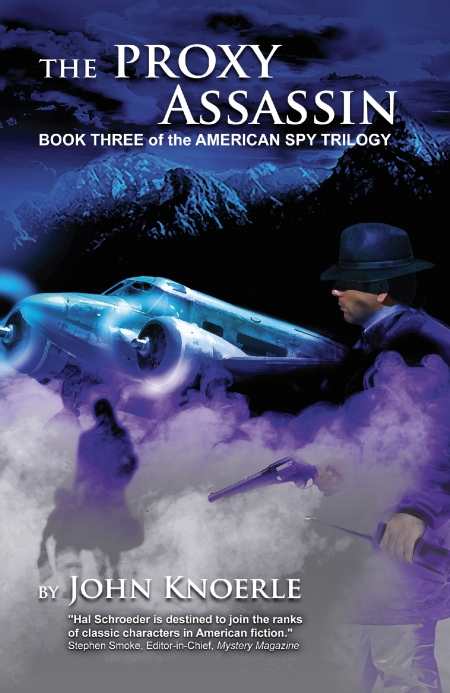It looks like you've stumbled upon a page meant to be read by our code instead of viewed directly. You're probably looking for this page.
The Proxy Assassin
Book Three of the American Spy Trilogy
“Dumb cowards live longer than smart heroes,” quips reluctant spy Hal Schroeder as his early Cold War mission to Romania starts to go sour. The main character and first-person narrator of John Knoerle’s American Spy Trilogy is, however, neither dumb nor a coward.
In The Proxy Assassin, the third book in the Schroeder saga, the former World War Two Office of Special Services operative and post-war undercover agent returns to active service at the behest of old comrades. “I don’t have anyone else with your behind the lines experience,” an old boss pleads with Schroeder. “They’re all dead.” Although he knows in his gut that his mission to go deep behind the Iron Curtain into Romania in 1948 is doomed before he even leaves the States, Schroeder bucks up and heads off anyway. Readers will be glad he does, for the action while over there is fast-paced, intriguing and best of all, filled with some good twists and turns.
Most of the book’s first 160 pages are very good—especially when Schroeder is on his mission overseas. The flashback chapters set in Washington, D. C., however, are far more predictable and static, although there and later in the book Knoerle’s hero hob-knobs with the likes of “Wild Bill” Donovan, J. Edgar Hoover, John Foster Dulles, Guy Burgess, Kim Philby, and other famous spies and spymasters of the era. Knoerle gets the look and feel of the Mayflower Hotel, Georgetown, and other D.C. landmarks, but it is not until he’s unleashed from these rather staid hitching posts that his storytelling really shines.
There is a light touch of Raymond Chandler to this writing, evidenced when he describes a Romanian princess as being “so perfect as to be almost beyond carnal desire,” or quipping as he does later that she is “one of those women you can’t take your eyes off of for fear you’ll miss something.” The former chief of her palace guard, Captain Sorin Dragomir, and the headman of the Magyar militia whom Schroeder encounters get similar treatment from Knoerle’s purple pen, which only adds to the novel’s enjoyment.
Knoerle’s book is a fun, light read that should appeal to fans of spy novels set in the late 1940s, back before the nuclear arms race overshadowed the more traditional cloak and dagger game of spies, coup plotters, revolutionaries, and insurrectionists.
The last 110 pages of the book are good, but anyone who has not read volumes one and two should stop before going there. While there is action aplenty, there is only a bare minimum of set up for this last 40 percent of the novel. Better the reader should refer to volumes one and two before finishing volume three; to do otherwise would be like flipping to the end of a story before reading the beginning and middle. And that would be a disservice to both Mr. Knoerle and to the reader.
Reviewed by
Mark McLaughlin
Disclosure: This article is not an endorsement, but a review. The publisher of this book provided free copies of the book and paid a small fee to have their book reviewed by a professional reviewer. Foreword Reviews and Clarion Reviews make no guarantee that the publisher will receive a positive review. Foreword Magazine, Inc. is disclosing this in accordance with the Federal Trade Commission’s 16 CFR, Part 255.
